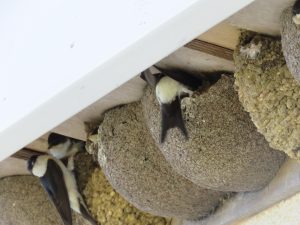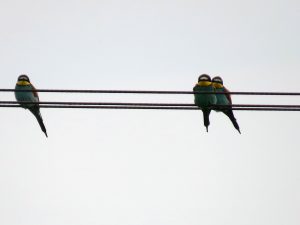As I write this article at the end of March, I am eagerly awaiting the arrival of the first house martin back in the colony on my Suffolk cottage.
Last spring, the earliest arrival date for this forty year old colony was broken by the earliest ever arrival on 1st April. The weather forecast had shown a warm front coming up from Africa and my wife and I decided to sit out in the garden on a very warm evening with a glass of wine, just in case!
Following the arrival of a single male the weather turned cold with frost every night with cool but sunny, dry days. Typical of these early returning birds our male roosted in the same complete nest every night but left the vicinity of the house each morning looking for a sheltered area, probably over water or in the lea of a wood, where the fairly scarce insects might be found. This male remained alone in the colony for seventeen days before warmer weather brought four more birds, one of which quickly joined him in his nest.
The colony then gradually built up to twenty-six pairs, close to the annual average for this site – over half the pairs occupying artificial nests. I am lucky enough to be invited to give illustrated talks about house martins at various natural history clubs and I often hear about the apparent ‘disappearance’ of early arrived house martins which have been surviving the difficult feeding conditions in the way I have just described.


While conducting survey work as a volunteer, rather than peer at house eaves from a distance – perhaps arousing suspicion (!!) – I used to knock on the doors of houses, at a reasonable hour, where martins were present. People were usually very happy to talk about ‘their’ house martins and would often produce details of arrival dates etc. and sometimes even coffee and cake as well!
One survey visit that sticks in my memory occurred during May when it was still much too early for any fledged young to be on the wing. The lady householder insisted that there were already young birds returning to the nest above her door. As we stood beneath the nest a pair of birds returned with the male closely following the female, typical of pairs still at the stage of mating and egg laying. No sooner had the chaperoning male entered the nest behind his partner than three more very boisterous males arrived and began forcing their way into the nest. Minutes later they were ejected one after another with one protesting loudly as it was still held by a wing tip by the rightful owner.
When I explained that male house martins commonly wait for neighbouring females to become receptive and then attempt to enter the nest to mate with them, the lady laughed and said, “The naughty boys – house martins are even more interesting than I thought!”
In the increasingly dry East Anglian climate, I like to try to find out during survey work where house martin colonies are finding their mud. Birds collecting mud seem to prefer a fairly open site where they feel safe to come down to the ground. House martin enthusiasts in a Cambridgeshire village had noticed birds using muddy puddles in a layby on the edge of their village. Householders interested in house martins then began keeping the puddles wet during dry spells with great success.
Only a few miles from my home, a colony nesting on a group of bungalows obtained their mud from the muddy grating covering the drain in an area used for washing trucks. These realities make the wetting of mud puddles where possible and the use of artificial nests particularly important.
Building sites are often important for house martins and are always worth inspecting when doing survey work. One on the edge of my nearest market town built several new houses over a period of ten years. The gable peaks of most of the earlier built houses contained at least one nest built with the mud supplied almost continuously from the adjacent current building area. Sadly, there is a recent trend for new houses to be built without eaves or even gable ends and with no overhang anywhere to provide shelter for natural nests.
If you are in a position to influence these important issues please look at the House Martin Conservation UK & Ireland website for inspiration.
Written by Martin Tickler

